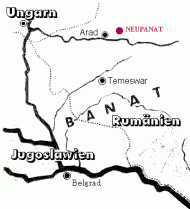The once pure-German community of Neupanat lies in the Arad region, north of the Marosch and about 5 miles north-east of Arad, on the Arad - Wilagosch (Hellburg) road.

The "Panad" settlement already existed in the Middle Ages in the region of todays community. Papal registers from the 14th Century confirm that there must have been a community here even as early as 1333. The then inhabitants of this community, with around 20 to 30 houses, were most probably Slavs or Magyars (this can be seen from the names of the villages). In 1561 Panath was still inhabited but shortly afterwards, the Arad region was invaded by the Turks (Ottomans) and they destroyed Panath. As a result, the inhabitants fled to the mountains or were killed by the Turks, that is, enslaved.
Only after the Peace Treaty of Karlowitz 1699 was the area north of the Marosch returned to Hungary. Panath became a ghost village. The inhabitants of the neighbouring villages now leased fields and pastureland there. On the orders of Kaiser Joseph II, 150 farmhouses were built in 1786-1787 on the Panat plains with a bursary (responsible for the settlement of German colonists). The settlement of Neupanat by German colonists was made via the Hungarian Court Chamber, which was subordinate to the Kaiser in Vienna.
The settlers followed the call of the Kaisers recruitment programme in Frankfurt, Rothenburg on the Neckar, Koblenz and Bonn, and arrived in Arad between May 28th and September 1785. They were accommodated in Glogowatz, Kovasintz, Menes and Kuvin. The colonial families spent over two years there. Besides, they had to live off the State because the building of the houses was a very slow process. At the end of 1786, the first settlers could, at long last, move in to the newly-built houses on the Panath plain. In January 1787, a further 56 families moved in and in the autumn the last colonists arrived.
The settlers came mainly from the south-west region of the German Reich, e.g. Alsace-Lorraine, the area today known as Saarland, the Rhineland, Westerwald, Hessen and Mainfranken.
The colonist houses were built from the hearth to the wall supports out of fired bricks and from the wall supports to the roof supports from unfired bricks.
Originally, two hundred colonial houses were to be built, but the neighbouring villagers protested and as a result, permission was granted for the building of only a hundred and fifty houses. Ninety houses were built facing north. The inhabitants numbered around 700, nearly all belonging to the Roman Catholic faith. The first mayor was Johannes Weber.
Each family received half an agricultural holding (600 fathoms?), 13 acres of agricultural land, 6 acres of meadowland and half a [house garden?]. From the settlement plan of 1786 we can see that plots of land were also provided for the building of a pub, and a house each for the priest and the school teacher.
From October 1787, Neupanat had its own clergyman, the Fransiscan monk, P. Fortunatus Friedrich (although the parish was part of the local chaplaincy of Glogowatz up until 1797). The keeping of registers also began, whereby the name Neo Panath (latin Neu Panath) was given. The seal of the parish, which was used from 1788 onwards, bears the inscription:
A document from 1794 shows that the lives of our ancestors was deeply rooted in faith and we can see that the inhabitants of Neupanat introduced five local Feast Days:
The name of the parish was: